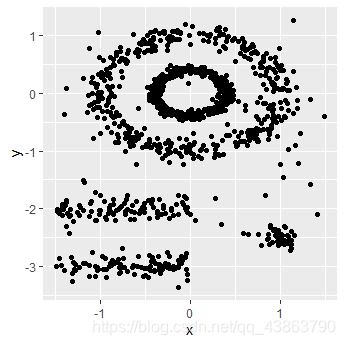一、 实验目的
- 了解DBSCAN算法基本原理;
- 编写代码并实现DBSCAN算法对数据的聚簇
二、 实验步骤
- 采用的数据集 :R语言factoextra包里的multishapes数据集

- 函数首先确定两个参数:
(1)epsilon:在一个点周围邻近区域的半径
(2)minPts:邻近区域内至少包含点的个数
根据以上两个参数,可以把样本中的点分成三类:
核点:满足领域内的点>=minPts,则为核样本点
边界点:满足领域内的点<minPts,但是该点可由一些核点获得
噪声点:既不是核点也不是边缘点,则是不属于这一类的点
- 用欧式距离计算点与点之间的距离矩阵disMatrix
- 为数据集添加visited列,0表示未访问,1表示访问过
- 判断点的类型存放到data_N
- 删除噪声点存放到data_C
- 重新计算距离,合并有交集的领域
- 为不同类型的点标签
- 绘图
三、 实验代码
library(factoextra)
library(ggplot2)
data<-data.frame(multishapes[,1:2])
ggplot(data,aes(x,y))+geom_point()
#主函数
DBSCAN = function(data,eps,MinPts){
rows = nrow(data)
disMatrix<-as.matrix(dist(data, method = "euclidean"))#求距离
data$visited <- rep(0,rows)
names(data)<-c("x","y","visited")
data_N = data.frame(matrix(NA,nrow =rows,ncol=3)) #领域集N,存放索引、领域内的点数、点的类型
names(data_N)<-c("index","pts","cluster")
#判断点的类型,1核心点,2边界点,0噪声点
for(i in 1:rows){
if(data$visited[i] == 0){ #未被访问的点
data$visited[i] = 1 #标记已经被访问
index <- which( disMatrix[i,] <= eps)
pts <- length(index)
if(pts >= MinPts){
data_N[i,]<-c(i,pts,"1")
}else if(pts>1 && pts< MinPts){
data_N[i,]<-c(i,pts,"2")
}else{
data_N[i,]<-c(i,pts,"0")
}
}
}
#删除噪声点
data_C<-data[which(data_N$cluster!=0),]
#去掉噪声点之后的领域
disMatrix2<-as.matrix(dist(data_C, method = "euclidean"))
Cluster<-list()
for(i in 1:nrow(data_C)){
Cluster[[i]]<-names(which(disMatrix2[i,]<= eps))
}
#合并有交集的邻域,生成一个新簇
for(i in 1:length(Cluster)){
for(j in 1:length(Cluster)){
if(i!=j && any(Cluster[[j]] %in% Cluster[[i]])){
if(data_N[Cluster[[i]][1],]$cluster=="1"){
Cluster[[i]]<-unique(append(Cluster[[i]],Cluster[[j]])) #合并,删除重复
Cluster[[j]]<-list()
}
}
}
}
newCluster<-list() #去掉空列表
for(i in 1:length(Cluster)){
if(length(Cluster[[i]])>0){
newCluster[[length(newCluster)+1]]<-Cluster[[i]]
}
}
#为相同簇中的对象赋相同的标签
data_C[,4]<-as.character()
for(i in 1:length(newCluster)){
for(j in 1:length(newCluster[[i]])){
data_C[newCluster[[i]][j],4]<-i
}
}
return(data_C)
}
#运行
test<-DBSCAN(data,0.15,6) #设定eps为0.15,minpts为6
ggplot(test,aes(x,y,colour=factor(test[,4])))+
geom_point(shape=factor(test[,4]))
四、 运行结果
原数据

经过聚类后

